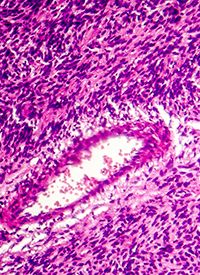Article
Intermittent Dosing Helps Mitigate Thrombocytopenia Associated With Milademetan in Sarcomas
Author(s):
Thrombocytopenia is a common adverse effect associated with treatment with the MDM2 inhibitor milademetan in patients with sarcomas and other solid tumors, and the effects of thrombocytopenia can be mitigated with an intermittent dosing schedule and managed with dose interruptions or reductions.
Milademetan in Sarcomas: © Dr_Microbe - stock.adobe.com

Thrombocytopenia is a common adverse effect (AE) associated with treatment with the MDM2 inhibitor milademetan (RAIN-32) in patients with sarcomas and other solid tumors, and the effects of thrombocytopenia can be mitigated with an intermittent dosing schedule and managed with dose interruptions or reductions, according to Chiara Fabbroni, MD.1
In a presentation at the 2023 ESMO Sarcoma and Rare Cancers Congress, Fabbroni noted that dose interruptions and reductions could prevent unnecessary treatment withdrawal, making them the preferred management options for thrombocytopenia associated with milademetan.
“Thrombocytopenia can be a problem in the use of milademetan. Sometimes it can be as deep as to require transfusion,” Fabbroni said. “However, when it does not require transfusion, the best management option here is to pause the treatment and resume it at a lower dose.” Fabbroni is a member of the Rare Cancer Unit at the Fondazione IRCCS Istituto Nazionale dei Tumori in Milan, Italy.
Nausea is another common AE linked with treatment with milademetan, Fabbroni noted. The use of antiemetics, such as 5HT-3 antagonists and benzodiazepines, could help prevent and manage nausea and/or vomiting in patients receiving the MDM2 inhibitor.
“Nausea can be referred as a symptom that can differ from one patient to another. Some patients refer to it as a symptom that starts at the beginning of [dosing], so from day one, and last all the days of [treatment],” Fabbroni said. “Some other patients refer [to] it as a symptom that also lasts for few days after [treatment]. It can be a symptom that really can affect quality of life of our patients.”
MDM2 amplification occurs in approximately 3.5% to 7.0% of patients across a broad range of solid tumors; however, there is currently no defined copy number threshold for defining MDM2 status.2,3 Additionally, MDM2 amplification can occur in the absence of TP53 mutations in several malignancies, including sarcoma, urothelial carcinoma, cholangiocarcinoma, and lung cancer.
Milademetan is a small-molecule MDM2-p53 inhibitor with a mechanism of action designed to reactivate p53 to induce apoptosis of TP53 wild-type malignant cells.1
“The selective toxicity on platelets that is typical of the MDM2 inhibitor class of drugs is likely due to the role played by p53 in the regulatory mechanism of megakaryocytes,” Fabbroni explained. “Namely, it is able to induce [apoptosis of] megakaryocyte progenitors and to affect megakaryocytes, [thereby] impairing the number of platelets.”
Safety data for milademetan have been documented in the phase 1 U101 trial (NCT01877382) in patients with advanced solid tumors. Additionally, the phase 3 MANTRA trial (NCT04979442) investigated milademetan in patients with dedifferentiated liposarcoma (DDLPS), and the ongoing phase 2 MANTRA-2 trial (NCT05012397) is further investigating the MDM2 inhibitor in patients with advanced/metastatic solid tumors with an MDM2 amplification.
U101 included patients with advanced solid tumors or lymphomas, and investigators preferentially enrolled patients with tumor types associated with a high prevalence of MDM2 amplification or overexpression.4
In the dose-escalation portion of the study, patients (n = 87) received milademetan on varying dose schedules. On the extended scheduled, the MDM2 inhibitor was given on days 1 to 21 of each 28-day cycle, and on the continuous schedule, milademetan was administered daily during each 28-day cycle. Two intermittent dosing schedules were also evaluated, including milademetan given once per day on days 1 to 7 of each 28-day cycle, as well as once per day on days 1 to 3 and days 15 to 17 of each 28-day cycle.
In dose expansion, patients (n = 20) received milademetan at 120 mg on days 1 to 21 every 28 days.
“This phase 1 study was to test different dose schedules. In one intermittent [schedule], milademetan [was] given at 260 mg from days 1 to 3 and days 15 to 17, every 4 weeks. That resulted as the best [dosing schedule] in terms of tolerability [and] maintaining efficacy,” Fabbroni said.
Regarding safety, the rates of any-grade and grade 3 or higher thrombocytopenia were 45% and 15%, respectively, in patients treated with 260 mg of milademetan on days 1 to 3 and 15 to 17 (n = 20). In patients treated on all other schedules (n = 78), the rates of any-grade and grade 3 or higher thrombocytopenia were 67% and 35%, respectively. Notably, no episodes of bleeding related to thrombocytopenia were reported in any patients.
Other hematological AEs in the intermittent dosing cohort included anemia (any-grade, 20%; grade ≥3, 0%) and neutropenia (any-grade, 10%; grade ≥3, 5%). In all other dosing cohorts, the rates of any-grade and grade 3 or higher AEs were 42% and 18%, respectively, for anemia, and 29% and 19%, respectively, for neutropenia.
Any-grade nausea and vomiting occurred in 80% and 50% of patients in the intermittent dosing cohort, respectively. Those rates were 73% and 28%, respectively, in all other cohorts.
MANTRA enrolled patients with unresectable and/or metastatic DDLPS, with or without a well-differentiated component. Patients were required to have progressed on 1 or more prior systemic therapies, including at least 1 anthracycline-based therapy.
Patients were randomly assigned 1:1 to receive 260 mg of milademetan on days 1 to 3 every 2 weeks or 1.5 mg/m2 of trabectedin as a 24-hour infusion once every 3 weeks. The primary end point of the study was progression-free survival (PFS) per blinded independent central review (BICR), and secondary end points included overall survival (OS), disease control rate (DCR), objective response rate (ORR), duration of response (DOR), investigator-assessed PFS, safety, and patient-reported outcomes.
Results from MANTRA are expected to read out in the first half of 2023.
In the ongoing MANTRA-2 study, patients are required to have locally advanced or metastatic TP53 wild-type solid tumors harboring an MDM2 amplification with a copy number of at least 8. Patients also need to have received all standard-of-care therapy appropriate for their tumor type and stage. All patients are receiving 260 mg of milademetan on days 1 to 3 every 2 weeks, with treatment continuing until disease progression, unmanageable toxicity, or other discontinuation criteria are met.
ORR is serving as the trial’s primary end point, and secondary end points consist of DOR, PFS, growth modulation index, DCR, OS, and health-related quality of life.
Among patients evaluable for safety from MANTRA-2 (n = 15) as of October 26, 2022, 27% experienced any-grade thrombocytopenia, including 20% who had grade 3 or higher thrombocytopenia.5 The rates of any-grade nausea and vomiting were 20% and 27%, respectively, and no grade 3 or higher events were reported for either AE.
“The [safety] results of the phase 2 study [thus far] were consistent with the ones previously observed in the phase 1 [trial], with thrombocytopenia and nausea as the most frequent [AEs] reported,” Fabbroni said.
When comparing the known safety profile of milademetan with other MDM2 inhibitors being evaluated in patients with sarcomas, such as siremadlin (HDM201), navtemadlin (KRT-232), and BI 907828, Fabbroni noted that the rates of thrombocytopenia and nausea were similar between milademetan and those agents.
With thrombocytopenia and nausea commonly associated with treatment with MDM2 inhibitors, Fabbroni said properly managing these AEs is necessary to ensure patients are able to continue treatment and derive potential efficacy from milademetan.
“The best thing to do is to personalize treatment as much as we can in order to maintain patients compliance and to optimize the potential benefit of [milademetan],” Fabbroni concluded.
Disclosure: Dr Fabbroni reported institutional financial interest in Advenchen, Amgen Dompe, Bayer, Boehringer Ingelheim, Daiichi Sankyo, Eli Lilly, Epizyme, GlaxoSmithKline, Karyopharm, Novartis, Pfizer, PharmaMar, Rain Oncology, and SpringWorks Therapeutics.
References
- Fabbroni C, Jones RL, Linback T, MacNeilly E, Xu F, Simeral L. MDM2 inhibitor milademetan: safety profile and management of adverse effects. Ann Oncol. 2023;8(suppl 3):101026. doi:10.1016/esmoop/esmoop101026
- Kato S, Ross JS, Gay L, et al. Analysis of MDM2 amplification: next-generation sequencing of patients with diverse malignancies. JCO Precis Oncol. 2018;2018:PO.17.00235. doi:10.1200/PO.17.00235
- Momand J, Jung D, Wilczynski S, Niland J. The MDM2 gene amplification database. Nucleic Acids Res. 1998;26(15):3453-3459. doi:10.1093/nar/26.15.3453
- Gounder MM, Bauer TM, Schwartz GK, et al. A first-in-human phase I study of milademetan, an MDM2 inhibitor, in patients with advanced liposarcoma, solid tumors, or lymphomas. J Clin Oncol. 2023;41(9):1714-1724. doi:10.1200/JCO.22.01285
- Fabbroni C, Jones RL, Napolitano A, et al. MDM2 inhibitor milademetan: safety profile and management of adverse events. Presented at: 2023 British Sarcoma Group Conference; March 22-23, 2023; Newport, Wales.








